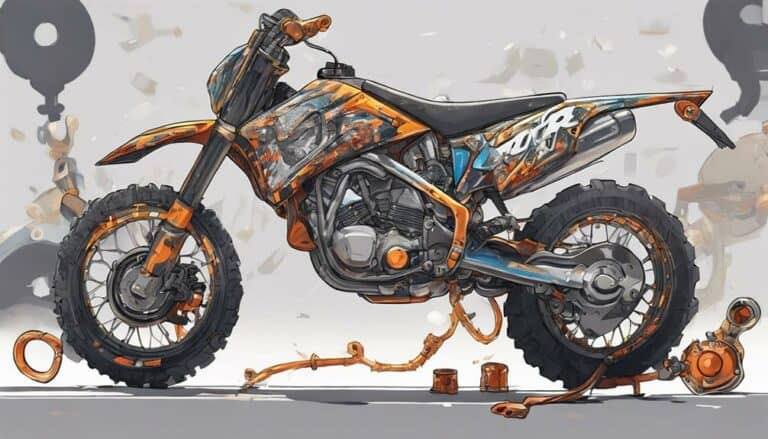When it comes to a dirt bike, attaching the exhaust is like connecting the final piece of a puzzle; it's essential for peak performance. But have you ever wondered where exactly the exhaust attaches on a dirt bike?
The answer might surprise you with its significance and impact on your riding experience. Stay tuned to uncover the mystery behind this crucial component and how it influences the overall functioning of your dirt bike.
Key Takeaways
- The exhaust attaches to the engine's exhaust port via the header pipe for gas collection.
- Proper alignment with the muffler ensures efficient airflow and gas expulsion.
- Mounting brackets and isolators secure the exhaust to the frame, preventing movement.
- Regular maintenance prevents leaks, ensures performance, and prolongs component longevity.
Locating the Exhaust on a Dirt Bike
When locating the exhaust on a dirt bike, observe the connection point where the header pipe links the exhaust to the engine's exhaust port. Proper exhaust mounting guarantees that the system is securely attached to the bike, preventing any rattling or unwanted movement during your ride.
Additionally, exhaust alignment plays an important role in optimizing the performance of your dirt bike. Misalignment can lead to inefficient exhaust gas flow, which may impact the bike's power delivery and overall efficiency.
To make sure proper exhaust alignment, inspect the mounting brackets and hangers for any signs of wear or damage. Make certain the exhaust system is positioned parallel to the frame of the bike, allowing for smooth and unrestricted airflow. Tighten all bolts and connections to secure the exhaust in place, preventing any leaks or loose components that could affect the bike's performance.
Understanding the Exhaust System Components
The exhaust system components on a dirt bike typically include a header pipe, muffler, and sometimes a mid-pipe. The header pipe serves as the initial connection between the engine and the exhaust system. It plays a critical role in guiding the exhaust gases from the engine to the muffler. The muffler, on the other hand, is designed to reduce noise levels while also controlling the flow of exhaust gases. By effectively dampening sound and regulating exhaust flow, the muffler enhances the overall performance of the dirt bike.
When considering exhaust system benefits, it's essential to acknowledge the role these components play in optimizing engine performance. Properly functioning exhaust systems can improve power output, fuel efficiency, and overall engine longevity. Further, exhaust system modifications, such as upgrading to high-performance headers or mufflers, can further enhance these benefits by increasing airflow and reducing back pressure.
Understanding the intricacies of the exhaust system components empowers riders to make informed decisions regarding modifications that can elevate their dirt bike's performance to new levels.
Attaching the Exhaust to the Engine
Attaching the exhaust to the engine involves securing the header pipe to the engine cylinders using tightly fastened bolts before connecting the muffler for best performance and to prevent exhaust leaks. The header pipe connection plays a critical role in collecting exhaust gases from the engine cylinders and directing them towards the muffler.
When attaching the muffler, precise alignment with the header pipe is essential to make sure proper airflow and efficient exhaust gas expulsion. Improper alignment could lead to performance issues, increased noise levels, and potential leaks.
Securing the Exhaust to the Frame
Mounting brackets and rubber isolators secure the dirt bike's exhaust to the frame near the rear of the bike. The exhaust mounting system is important for maintaining the stability of the exhaust components during the bike's operation. Typically, the exhaust system consists of a header pipe and a muffler, both of which need to be correctly aligned and connected to guarantee peak performance. The frame connection is essential in preventing the exhaust from rattling or moving excessively while riding.
To secure the exhaust to the frame, bolts are used to fasten the mounting brackets in place. Rubber isolators play an important role in absorbing vibrations and shocks, which helps in reducing stress on the exhaust system and the frame. Regular inspection of the exhaust mounting hardware is necessary to check for any signs of wear or loosening. Ensuring a tight and secure connection between the exhaust and the frame will help prevent potential issues and maintain the overall performance of the dirt bike.
Checking for Exhaust Leaks and Maintenance
Securing the exhaust to the frame guarantees proper alignment and connection, which is essential for peak performance and stability during operation. To make sure your dirt bike's exhaust system is in top condition, follow these essential steps:
- Exhaust Pipe Inspection: Regularly inspect exhaust gaskets and seals for any signs of wear or damage. Look for black soot around exhaust joints as an indicator of potential leaks. Additionally, use a flashlight to check for any cracks or holes in the exhaust system.
- Leak Prevention Techniques: To prevent leaks, tighten exhaust bolts and clamps periodically to maintain a secure connection. Consider using high-temperature silicone or exhaust sealant for added leak prevention.
- Maintenance: Perform routine maintenance on your exhaust system to prolong its lifespan. Clean the exhaust pipe regularly to prevent buildup and corrosion. Inspect the entire system for any loose components or abnormalities that may impact performance.
Conclusion
Now that you've successfully attached the exhaust to your dirt bike, you're ready to hit the trails and experience the power and performance upgrades firsthand.
Remember to regularly check for exhaust leaks and perform maintenance to keep your bike running smoothly.
With your new aftermarket exhaust from MXstore, you'll be tearing up the track like a boss.
Time to rev up and ride into the sunset with confidence!

